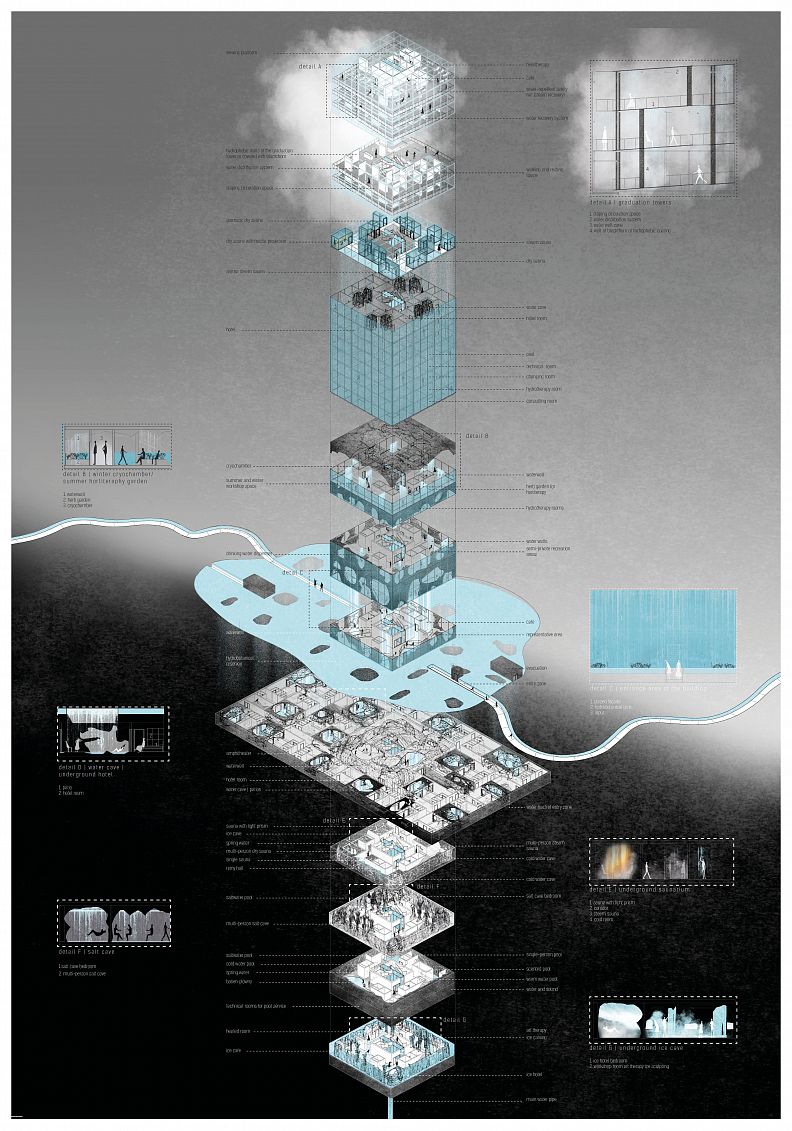Wir - water and regeneration - technological use of water as an element shaping the new dimension of space in spa architecture

Idea projektu
The deepening process of "dynamic lifestyle" by modern society leads to an increasing perception of stress in people's everyday life. The increase in its intensity has contributed to its designation as a civilization disease of the 21st century. Spas are returning the favor. Interest in spa tourism no longer concerns only the elderly, but also gains the attention of young people who need to regenerate their bodies and minds. That is why it is important to create an open architecture, taking into account the element of water which stimulates human senses and brings man closer to his relationship with nature. In addition, the dynamic lifestyle and interest in spa tourism leads to dynamic uncontrolled development of the urban fabric structure of spas. This type of process may contribute in the future to the reduction of the natural values of the given areas and thus their negative impact on the appropriate conditions for the curing process. The graduation project "Water Serenity" is a work that aims to make us reflect on these issues, and in addition, to address the issue of water in the spa space as an element that supports the healing process and stress relief. Additionally, the project of the health resort in Brzozów-Zdrój is an attempt to respond to the existing social and spatial problems. The architectural intervention is defined by the idea of integrating the object into the natural topography of the place and restoring its lost identity. Conducted research and case studies have led to the conclusion that the spa facilities should have the character of space bringing people closer to the relationship with nature by making water visible. The physical variability of this matter allows for interesting technological solutions, enabling the construction of narratives and atmospheres inside them, blurring the barrier between open and closed space. In addition, the presence of water has a positive effect on the patients' treatment.
Popis projektu
The aim of the work, is creation of spa architecture, which task is to shape the space conditioned by technological use of water for its formation. In addition, creating the atmosphere of a place affecting the senses, soothing, reducing stress and promoting the processes of regeneration of body and soul of patients. These have been implemented in the form of an unconventional vertical spa structure. The essence of spa architecture is to provide adequate space to support the regeneration of the user in, not only through its functionality, but also to intensify the bather with what is natural in the built environment. Water, which comes from nature, is one of the commonly used elements in spa treatment and therefore its presence should accompany the creation of this relationship. The design process and activities on the study models enabled the creation of a new spatial vision in spa architecture, defining the internal and external form of the building. Dominance in the landscape of the object through its vertical structure form was conditioned by the historical identity of the place, referring to the oil wells that formed part of the landscape of the Podkarpacie region. The urban-architectural intervention in the area of the former health resort in Brzozów - Zdrój was to become a model example for the reactivation of old places and new places that favour the health resort function, preserving their cultural richness and historical heritage through the manner and quality of created architecture. Architecture in such areas should focus on their individual character, history and environmental conditions making them unique and identified with them.
Technické informace
The building was designed in the wall construction system for the entire underground part and for the first five floors above ground. From level +5 to +13 a skeleton system is used, which consists of 20x20 cm square columns. From level +14 of the building to the highest level, the structure is formed by a truss system with a module of 2.1 meters, whose elements are steel rods with a cross-section of 15x15cm square. Additional stiffness of the structure of the building is ensured by the core located in its central part, which consists of reinforced concrete walls prefabricated with a thickness of 40cm up to level +13, from level +14 upwards it is a steel frame structure with 20x20cm square columns. Partition walls are foreseen in the system of prefabricated reinforced concrete walls 15 cm thick. Ceilings and flat roofs are designed with prefabricated slabs supported on steel beams. In the underground and above ground parts up to level +4 the walls and ceilings will remain with the concrete texture, the interiors will be enriched with wooden accents. From level +5 to +13 the walls will be finished with mirror panels, the facade of the building will be covered with semi-transparent glass. From level +14 to the highest level, the ceiling and wall elements will be replaced with perforated metal shell, giving lightness and openwork to the interior. The vertical structure is distinguished by gradation of materials: from the monolithic form of stone, semi-transparent glass facade, ending with a delicate structure of metal lattice. The material finish alludes to the 3rd physical state of water.















